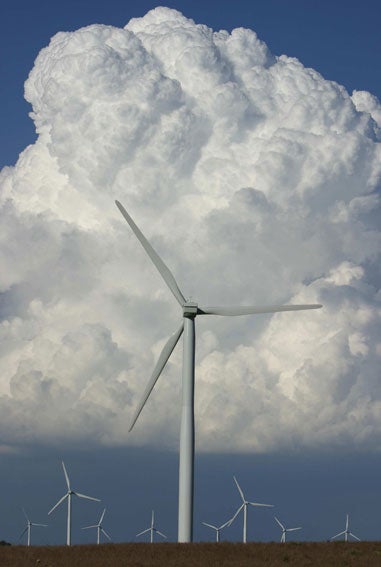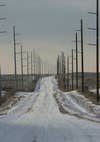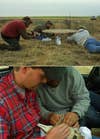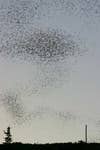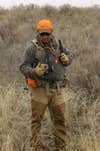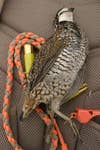Oklahoma’s wind power may be clean energy, better than oil or natural gas, but the spread of windfarms still hurts hunting and w
A row of wind turbines in Harper County, Oklahoma. Depending on the model, each turbine can produce 1.5 to 2.1 megawatts of electricity when spinning. Nowhere is this more evident than on the sage-covered prairies of northwestern Oklahoma. Hundreds of wind turbines stretch like a giant picket fence across the landscape, towering above the game-rich high plains. At first glance it would seem to be a win-win for both the environment and society: a clean, non-polluting energy source that never runs out.
Oklahoma’s wind power may be clean energy, better than oil or natural gas, but the spread of windfarms still hurts hunting and w
Wind turbines near the border of the 16,000-acre Cooper Wildlife Management Area (WMA) in Harper County, Oklahoma. Currently there are 193 wind turbines in Woodward and Harper Counties, with hundreds more planned. When it comes to energy production, however, you never get something for nothing. Case in point: as a result of this boom, one of the nation’s top public land bobwhite quail hunting destinations may soon be covered with a network of roads, high-tension power lines, and wind turbines. The Oklahoma Wildlife Conservation Commission is considering a proposal to allow development on a section of the Hal and Fern Cooper Wildlife Management Area north of Woodward, Oklahoma.
Oklahoma’s wind power may be clean energy, better than oil or natural gas, but the spread of windfarms still hurts hunting and w
A bobwhite quail perches on a sagebrush in the Cooper WMA. Depending on weather and habitat conditions, quail populations can fluctuate wildly from year to year. At 16,000 acres, Cooper WMA is not the largest public hunting area in western Oklahoma, but it’s located in the heart of the nation’s best remaining bobwhite quail habitat.
Oklahoma’s wind power may be clean energy, better than oil or natural gas, but the spread of windfarms still hurts hunting and w
A pair of ducks takes off from a windmill stock tank on Cooper WMA. Traditional windmills use wind-powered pumps to draw underground water to the surface where it is stored in tanks or small ponds. The concept of putting the wind to work is by no means a new one on the plains. The eminent historian Walter Prescott Webb considered the windmill one of the three most important tools for the development of the west, equally as important as the six-shooter and barbed wire.
Oklahoma’s wind power may be clean energy, better than oil or natural gas, but the spread of windfarms still hurts hunting and w
Old and new technology, side by side in Woodward County. Traditional prairie windmills are rarely over 50 feet tall; modern turbine towers can exceed 300 feet in height. Even today, in this era of solar pumps and mechanized irrigation thousands of working windmills still dot the area, using the wind to pump groundwater for livestock and wildlife alike.
Oklahoma’s wind power may be clean energy, better than oil or natural gas, but the spread of windfarms still hurts hunting and w
Wind turbines ring both sides of this section of Cooper WMA. It’s estimated that Oklahoma has enough wind energy potential to supply 10 percent of the nation’s electricity needs. But it is our insatiable and constantly growing need for energy that is driving the new era in wind power, and there are very few places in the world where the wind blows as consistently as it does in Oklahoma, which has been described as “The Saudi Arabia of Wind Energy.-¿ Up to this point virtually all wind farm development in the southern plains has taken place on private land. Most hunters probably consider public land energy issues the exclusive domain of western states. But not any more. As wind turbines get more efficient and the rising costs of fossil fuels continue to make alternatives like wind more profitable, many wildlife professionals believe public hunting areas will increasingly become targets for development.
Oklahoma’s wind power may be clean energy, better than oil or natural gas, but the spread of windfarms still hurts hunting and w
Newly constructed high-tension power lines frame a county road that cuts through Cooper. Turbines need consistent winds in the 15-17 mph range to efficiently produce electricity. Wind energy is touted as clean, safe and benign, but there are a host of contentious issues surrounding it, including habitat fragmentation due to roads, high-tension lines, and the turbines themselves. The towers soar as high as three hundred feet above the ground and the three-bladed turbines sitting atop them cut a swath through the air hundreds of feet in diameter. Viewed from a distance, the miles-long rows of turbines give the illusion of a slowly-undulating landscape. Viewed from up close the intimidating structures dominate your perspective. High-tension powerlines from encroaching wind farms already cut across the parts of the Cooper WMA. If development is approved even more right-of-ways and access roads will need to be cut.
Oklahoma’s wind power may be clean energy, better than oil or natural gas, but the spread of windfarms still hurts hunting and w
A male prairie chicken on a northwest Oklahoma booming ground. Prairie chickens return to the same grounds, or leks, every spring. Further complicating the issue is the plight of declining prairie grouse populations, specifically the lesser prairie chicken. Cooper WMA is located in one of the very last areas where this once prolific prairie icon can be found, and even here the bird is fast disappearing. Once so numerous they were hunted for market, lesser prairie chickens now appear on their traditional spring booming grounds in lonely groups of twos and threes. Many leks have fallen into permanent silence.
Oklahoma’s wind power may be clean energy, better than oil or natural gas, but the spread of windfarms still hurts hunting and w
Researchers from the George M. Sutton Avian Research Center trap prairie chickens northwest of Cooper WMA and attach radio collars to the birds’ necks. After the bird is released and the collar transmits the chicken’s location and movement patterns. The George M. Sutton Avian Research Center has conducted a long-term study of the lesser prairie chicken in the same area around Cooper that is currently under intense wind farm development. By trapping and radio-collaring prairie chickens, researchers have begun to understand some of the factors influencing prairie chicken mortality and survivability.
Oklahoma’s wind power may be clean energy, better than oil or natural gas, but the spread of windfarms still hurts hunting and w
Researchers have discovered that up to 10 percent of prairie chicken mortality is due to collisions with fences and wires. Increasing fence visibility with flags helps the low-flying chickens to avoid them. The key to prairie chicken viability is habitat. Prairie chickens don’t do well around unmarked fences, powerlines, and other vertical structures. They have evolved purely as a creature of the unbroken plains. If wind turbines are constructed on Cooper, researchers fear that might toll the death-knell for the WMA as a viable habitat for prairie chicken recovery.
Oklahoma’s wind power may be clean energy, better than oil or natural gas, but the spread of windfarms still hurts hunting and w
Mexican free-tailed bats fill the night sky at the Selmon Bat Cave north of Cooper WMA. There have even been questions about how bats might be adversely affected by the breakneck proliferation of wind turbine development in western Oklahoma. Each night in the summer at a state-owned parcel of land not too far from Cooper WMA, a crowd of people gathers to watch an amazing nightly spectacle; a smoke-like plume comprised of millions of Mexican free-tailed bats pours out of a cave into the night sky. It is an extremely popular wildlife department program that some feel may be threatened if wind farm development expands too much
Oklahoma’s wind power may be clean energy, better than oil or natural gas, but the spread of windfarms still hurts hunting and w
“Okie” and “Ted” wait to run during a northwest Oklahoma quail hunt. Their owner, Dave Brown, travels from Canada to Oklahoma every year to guide quail hunters from across the nation. But it is the potential effect on the public hunting area itself that is of the most concern to sportsmen. Each year thousands of hunters from across the continent travel to Cooper and the area of northwestern Oklahoma surrounding it in pursuit of the kind of quail hunting long absent from most of the bobwhite’s traditional range.
Oklahoma’s wind power may be clean energy, better than oil or natural gas, but the spread of windfarms still hurts hunting and w
Brown with a quail brought to hand by one of his dogs. For most hunters there is as much aesthetic appeal in hunting the wide-open spaces of these sage-covered plains as there is in the promise of finding birds.
Oklahoma’s wind power may be clean energy, better than oil or natural gas, but the spread of windfarms still hurts hunting and w
It’s the kind of country where big-running, hard-charging dogs beg to be let out of the box …
Oklahoma’s wind power may be clean energy, better than oil or natural gas, but the spread of windfarms still hurts hunting and w
… and stretch it out in the kind of country equal to their desire.
Oklahoma’s wind power may be clean energy, better than oil or natural gas, but the spread of windfarms still hurts hunting and w
A northwest Oklahoma bobwhite. Each year hunters in Oklahoma harvest anywhere from 800,000 to several million quail, depending on bird populations and conditions during hunting season. The decision to develop wind energy on public land in Oklahoma rests in the hands of the Oklahoma Wildlife Conservation Commission, a group of political appointees chosen by the governor mainly on the strength of their patronage rather than any intrinsic knowledge of wildlife issues. It remains to be seen whether they will side with their constituency or side with corporate interests. A decision is still some time away and publicly the Oklahoma Department of Wildlife Conservation is still studying the issue, though privately many of its rank-and-file are concerned about the outcome. In the words of one wildlife department employee “we know other wildlife agencies around the country are watching us see what happens at Cooper. This is going to set a precedent, good or bad.-¿
